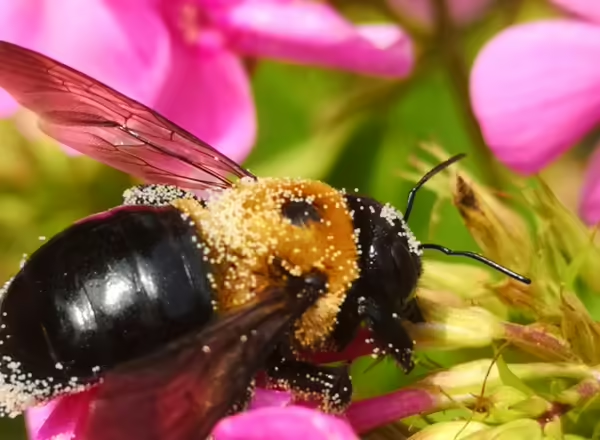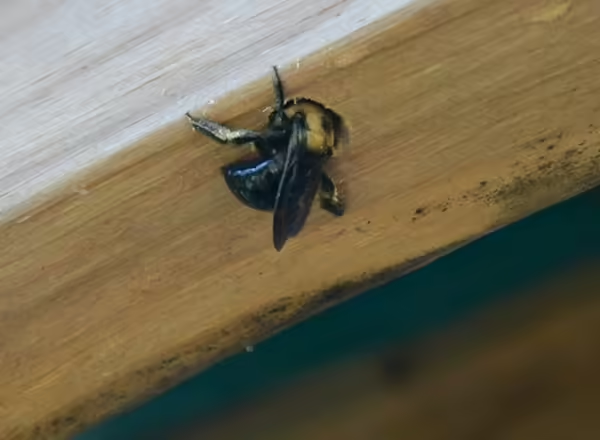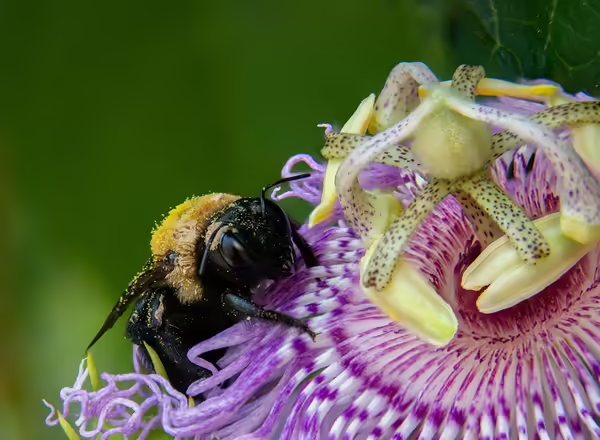
Bees are a welcome site in our gardens. Without the help of bees (and other pollinators) pollinating many of our plants, we wouldn’t be able to enjoy the myriad of flowers, fruits, and vegetables we have in our landscapes. Despite all their benefits, one bee species may not always be a welcome sight, particularly around decks, fences, and eaves, carpenter bees.
Is it a carpenter bee or a bumble bee?
Eastern carpenter bees (Xylocopa virginica) are often confused for bumble bees because they are similar in size (3/4 to 7/8 inch) and appearance. However, they are relatively easy to tell apart if you look closely. Carpenter bees have bare, shiny abdomens, while bumble bees are hairy.
In addition to their appearance, carpenter and bumble bees’ nests also differ. Bumble bees are social insects that build their nests in existing cavities, often in the ground. Meanwhile, carpenter bees are typically solitary and build their nests above ground in wood.


Eastern carpenter bee life cycle
Carpenter bees will over winter in tunnels as young adults. Come spring (April and May), they will emerge and mate. Afterward, the females will either enlarge existing tunnels or begin to build new tunnels. If a female starts constructing a new tunnel, she chews a nearly perfect circle about ½ inch in diameter. She will tunnel straight into the wood before making a 90-degree turn and burrowing with the grain of the wood (easier to excavate compared to burrowing perpendicular to wood grain).
Females will lay eggs in the tunnels and provide them with bee bread (a mixture of pollen and nectar). Each egg will be sealed off into individual chambers using a combination of wood pulp and saliva. A female usually produces 6 to 8 chambers in newly excavated nests. The eggs will hatch, and the larvae will feed and pupate; new adults will emerge in August or September. They will feed and then go back into the tunnels to overwinter.
What’s the problem?
Carpenter bees get a bad name because they build their nests in wood, often in outdoor wood structures such as decks or the eaves of homes. They will use many species of dried, seasoned wood. However, they prefer soft woods like pine, fir, redwood, and cedar. Unlike some other insects, like termites, they do not feed on the wood, they are simply excavating it to create a nest.
The primary problem with carpenter bee nesting is cosmetic. In addition to unsightly holes, the bees will defecate before they enter their tunnels, which can stain surfaces beneath the holes. Woodpeckers may also damage wood in search of the bee larvae.
Typically, carpenter bee holes don’t cause serious structural damage. On some occasions, though, if the tunnels get large enough (used for several years), or if there are multiple nests built in the same piece of wood (over several years), it may compromise the structural integrity of the wood, and it will need to be replaced. Additionally, the holes in the wood can allow moisture to get in, potentially leading to rot and decay.
Male carpenter bees can also be a nuisance in the spring. They will establish territories near nests and flowers and patrol them. They will aggressively defend their territory from intruders, whether it be other male carpenter bees, pets, or people.
Fortunately for us, male bees lack a sting and are incapable of stinging (it’s all a show). Females, on the other hand, can sting. However, they are not aggressive, but if handled, they may sting. If you are unsure if a bee is male or female, look at its face, male bees have a whiteish spot on their faces.



What can I do to manage carpenter bees?
Before carpenter bees become a problem, you can deter nesting by painting or varnishing exposed wood. Carpenter bees find painted surfaces less attractive than raw wood. If wood has been damaged, it can be replaced with painted wood or a non-wood substitute (composite, vinyl, aluminum, etc.).
If you feel you need to get rid of existing carpenter bees, insecticides can be used. The best time to treat is in the spring when bees are first being observed. Individual tunnel openings can be treated with an insecticidal spray or dust. Make sure to read and follow all label directions.
A week or so after treatment, the holes should be plugged (caulk, wood putty, or wooden dowels) to prevent them from being used again. The surface should be painted or varnished, which will discourage subsequent nests from carpenter bees.
Despite the problems they may cause, carpenter bees are beneficial insects to have around. They will pollinate a variety of different flowers, particularly large open-faced flowers such as sunflowers, coneflowers, and asters. If you want to try attracting carpenter bees, offer alternative nesting areas, such as tree stumps (with bark removed) and logs.
Good Growing Fact of the Week: While originally considered solitary, some carpenter bees may nest together when resources are scarce. These groups have a dominant female who lays eggs and forages for food. Subordinate females may help defend the nest or bide their time until they become the dominant female the following year.
Signup for our emails! Want to get notified when new Good Growing posts are available? SIGN ME UP
MEET THE AUTHOR
Ken Johnson is a Horticulture Educator with University of Illinois Extension, serving Calhoun, Cass, Greene, Morgan, and Scott counties since 2013. Ken provides horticulture programming with an emphasis on fruit and vegetable production, pest management, and beneficial insects. Through his programming, he aims to increase backyard food production and foster a greater appreciation of insects.